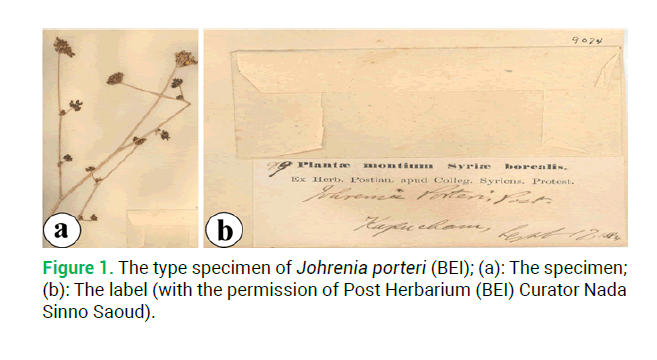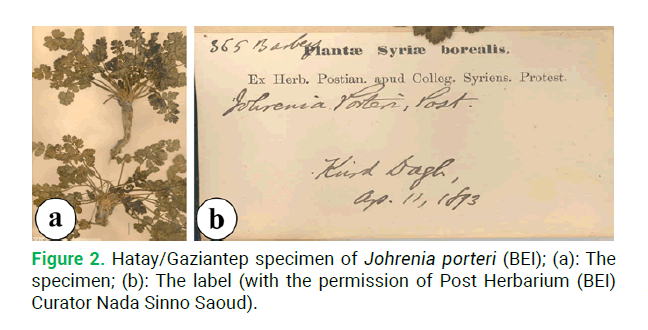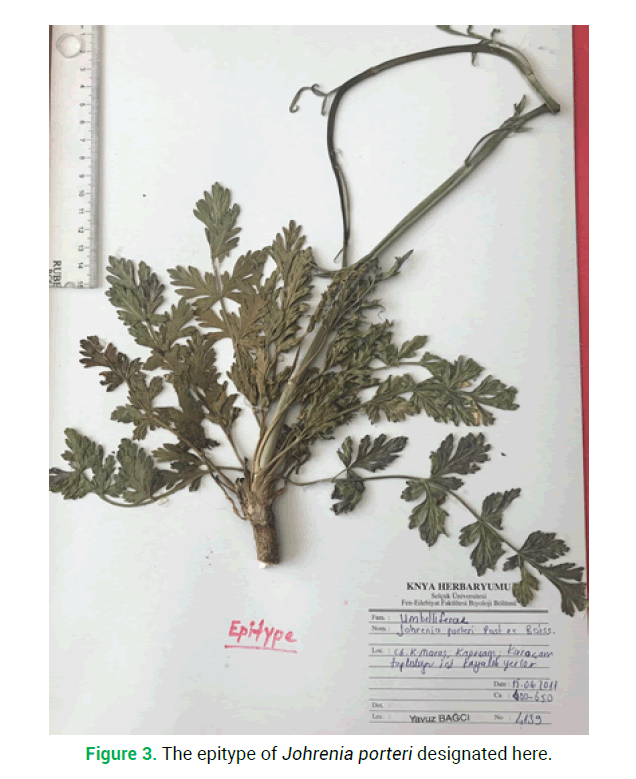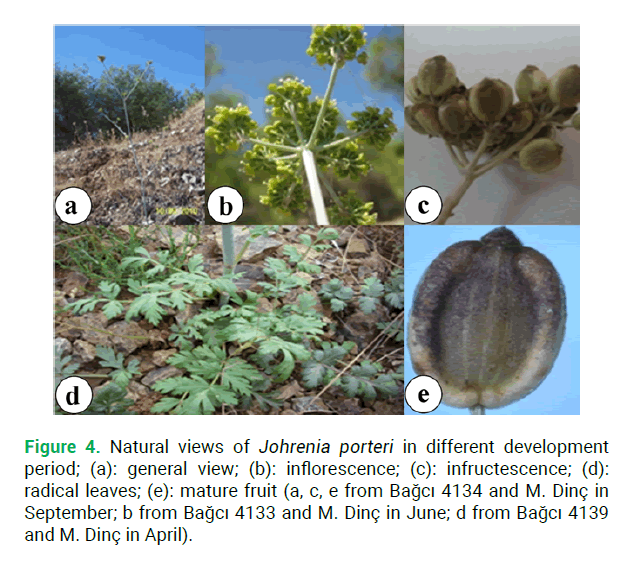Research - Modern Phytomorphology ( 2021) Volume 15, Issue 3
Critical taxonomical notes on poorly known Johrenia porteri Post ex Boiss. (Apiaceae)
Yavuz Bagci1 and Muhittin Dinc2*2Ahmet Kelesoglu Faculty of Education, Necmettin Erbakan University, Meram, Konya, Turkey
Muhittin Dinc, Ahmet Kelesoglu Faculty of Education, Necmettin Erbakan University, Meram, Konya, Turkey, Email: muhdinc@yahoo.com
Received: 30-Apr-2021 Accepted: 28-May-2021 Published: 07-Jun-2021, DOI: 10.5281/zenodo.5801150
Abstract
In addition to the incomplete type from Turkey, Johrenia porteri Post ex Boiss. is known from only two herbarium specimens of doubtful systematic position from Turkey-Syria border. The deficiencies in both type and other herbarium samples have been caused uncertainty and debate about the taxonomic position of the species. In this article, Johrenia porteri is epitipified and its taxonomic position has been clarified. The description of the species has been expanded with the studies conducted within the scope of the samples collected in different developmental periods from the type locality as well.
Keywords
Eudicots, epitipification, Johrenia, Turkey
Introduction
The genus Johrenia (Apiaceae), known in Turkey with the Turkish name "Irazotu" (Güner et al. 2012), was described by Candolle (1829) based on J. dichotoma DC. According to the latest taxonomic analysis on some of the genera in Apiaceae, the generic name Dichoropetalum Fenzl has been restored and some species of Johrenia s.l. in Turkey have been transferred to Dichoropetalum (Pimenov et al. 2007). After this taxonomic arrangement, which was not adopted in the "Turkiye Bitkileri Listesi (Damarlı Bitkiler)" the number of taxa of the genus Johrenia distributed in Turkey has become 3. These taxa are Johrenia silenoides Boiss. et. Bal., J. porteri and J. dichotoma DC. (Chamberlain 1972; Pimenov et al. 2007; Menemen 2012).
Johrenia porteri is a poorly known species due to many taxonomic confusions. This species has been published from Kahramanmaraş (Boissier 1888), depending on the flowering and young fruity type specimens whose rosette leaves were missing (in G and BEI). In addition, the species has been known from doubtful specimens from another locality in Turkey (Hatay/Gaziantep: Kurd Da., in BEI and B) and from Syria (Chamberlain 1972; Pimenov et al. 2007).
Unlike type specimens, the specimens from Hatay/Gaziantep are stemless and consist only of rosette leaves. Therefore, it has been reported that the origin of these specimens is not known and may represent another species (Pimenov et al. 2007). Bormüller (1930) reported that these samples belong to Pimpinella saxifraga L., but Pimenov et al. (2007) stated that this sample may be more suitable for Pimpinella corymbosa Boiss.
The taxonomic confusions do not allow the taxon identified as the Johrenia porteri to be accurately attributed to any genus, and type specimens in G and BEI and the others in B and BEI are not sufficient to clarify the taxonomic position of it. As the most probable taxonomic solution, it has been proposed to attribute the type specimens in BEI and G to Peucedanum junceum (Boissier) Mouterde and the others in B and BEI to Pimpinella corymbosa (Pimenov et al. 2007). The studies on more complete specimens from around the type locality are required (Pimenov et al. 2007). Although some studies have been done on the materials collected from the type locality before (Dogan et al. 2010; Ceter et al. 2012; Bagci and Dinc 2012), there is no published comprehensive study on the solution of taxonomic confusion. In this study, it is aimed to clarify the taxonomic position of J. porteri within the scope of the samples collected around the type locality.
Materials and Methods
In order to solve this taxonomic confusion, the field studies were carried out in Kahramanmaraş Kapuçam Mevkii, which is the type locality of J. porteri in different development periods. The specimens were collected both in April-June, when the individuals were in early vegetative development, and in July and September, when they were flowering and fruiting. These specimens are kept in KNYA herbarium. Morphological characters of the studied specimens were examined by using a binocular stereoscopic microscope and compared with the type specimen. The specimens examined as follows; [C6 Maras] in Syriae borealis collibus siccis ad Kapukhan ditionis Marasch (type BEI photo!); C6 Hatay/Gaziantep; Kurd dagı (BEI photo!); C6 Maras, Kapucam, Karacam toplulugu ici acik ve taslik-kayalik yerler, 600 m-650 m, 08.07.2009, Bagci 3735 and M.Dinc (KNYA); ibid., 600 m-650 m, 13.07.2010, Bagci 4118 and M. Dinc (KNYA); ibid., 06.08.2010, Bagci 4132 and M. Dinc (KNYA); ibid., 650 m-655 m, 10.09.2010, Bagci 4134 and M. Dinc (KNYA); ibid., 600 m-650 m, 15.04.2011, Bagci 4139 and M. Dinc (KNYA); ibid., 655 m, 01.06.2011, Bagci 4193 and M. Dinc (KNYA).
Results
The reason for the taxonomic uncertainty about Johrenia porteri is the missing type sample (Fig. 1) and the other herbarium sample (Fig. 2). The previous studies on the two type materials of J. porteri indicated that among the flowering and immature fruited samples, the one found in G was the holotype (i.e lectotype) and the one found in BEI was the isotype (i.e isolectotype) (Pimenov et al. 2007). As a result of this study, J. porteri is epitipified (Fig. 3) and its description is expanded within the scope of many examples collected from type locality.

Figure 1: The type specimen of Johrenia porteri (BEI); (a): The specimen; (b): The label (with the permission of Post Herbarium (BEI) Curator Nada Sinno Saoud).

Figure 2: Hatay/Gaziantep specimen of Johrenia porteri (BEI); (a): The specimen; (b): The label (with the permission of Post Herbarium (BEI) Curator Nada Sinno Saoud).

Figure 3: The epitype of Johrenia porteri designated here.
Taxonomy
Johrenia porteri Post ex Boiss., Fl. Or. Suppl. 266 (1888)
Type: [Turkey C6 Maraş] in Syriae borealis collibus siccis and Kapukhan ditionis Marasch (lecto. G, isolecto. BEI photo!) (Fig. 1)
Epitype (designated here): [Turkey] C6 Kahramanmaraş: Kapuçam Mevkii, Karaçam topluluğu içi açık ve taşlık-kayalık yerler, 600 m-650 m, 15.04.2011, Bağcı 4139 and M. Dinç (KNYA) (Fig. 3).
Description: Tall perennial herbs. Rootstock thick, branched, crowned by a week fibrous collar. Stem up to 200 cm long, strongly glaucous dichotomously branched above the middle, 5 mm-10 mm diameter, striate below and above, with withered petiols remaining from former year at base. Basal leaves 1-pinnate, up to 15 cm, oblong in outline, with 4-6 paired leaflets, ultimate leaf segments pinnatifid to pinnatisect, with linear to oblong lobe, glabrous, drying before anthessis; lower and median cauline leaves smaller with 2-3 paired undivided or trisect leaflets; upper leaves wholly reduced, simple and sessile. Basal leaf petioles up to 5 cm long and 3 mm-5 mm wide. Inflorescense dichotomously branched, umbels unequally 5-12 rayed, rays diffuse in flowering time, nearly erect in fruiting time; bracteoles 5-8, herbaceous, 3 mm-4 mm long, triangular lanceolate, strongly deflexed at fruiting time. Peduncles 0.5 cm-20 cm, rays 0.5 cm-2.5 cm, pedicels 4 mm-5 mm in fruiting. Flowers yellow, minute Stylopodium plane or slightly conic. Ripe fruit oblong-elliptic to ovoid, (5.2 mm-6.2 mm) × (3.3 mm-4.0 mm), exterior vittae embedded in the thick white margin, central area remaining green and differentiated (Figs. 3 and 4).

Figure 4: Natural views of Johrenia porteri in different development period; (a): general view; (b): inflorescence; (c): infructescence; (d): radical leaves; (e): mature fruit (a, c, e from Bağcı 4134 and M. Dinç in September; b from Bağcı 4133 and M. Dinç in June; d from Bağcı 4139 and M. Dinç in April).
Discussion and Conclusion
The observations during field studies indicate that the deficiencies in herbarium samples that cause taxonomic confusion are due to the development characteristics of the species because at the beginning of the stem development, the rosette leaves dry and crumble completely. Therefore, herbarium samples were collected incompletely and this caused taxonomic controversy and confusion. In this study, the taxonomic status of the species was clarified by eptipification.
The specimens in each development period obtained from the type locality, especially with their flower and fruit characters (yellow petals, the wingless mericarps, green in the middle, white and swollen-spongy at the margins, interior three ridges on the center of the mericarp reduced to raised lines, exterior two embedded in the thick margin etc.), are clearly compatible with the genus Johrenia. Therefore, it is suitable for this species to remain taxonomically in the genus Johrenia.
It has been reported that stemless J. porteri specimens from Hatay/Gaziantep may represent another species included in the genus Pimpinella L. (Bormüller 1930; Pimenov et al. 2007). Within the scope of the study, the comparative examination of the samples collected from the type locality of J. porteri indicates that the samples of Hatay/Gaziantep belong to J. porteri.
The only recorded specimen of J. porteri from Syria is identified by Mouterde (1970). However, Pimenov et al. (2007) stated that unlike the type of J. porteri, with the well-developed bracteoles that characteristically surpass umbellule, it probably belongs to recently described Peucedanum longibracteolatum (Parolly and Nordt 2005) or its close relative. In none of J. porteri samples collected from the type locality, the bracteoles do not exceed the umbellules. This situation supports the opinion of Pimenov et al. (2007) about the systematic position of the Syrian example.
Conservation status
The data obtained from the study show that J. porteri is a stenoendemic species known from only two localities approximately 100 km apart from each other in Turkey. The EOO (Extent of occurrence) is less than 100 km2, the AOO (Area of Occupancy) is less than 10 km2, and total number of mature individuals is approximately 100. The population at type locality is very near to picnic area, and under the serious threat of overgrazing. Based on these data and by the application of the criterion B1, B2ab (i,ii,v), this species is here assessed as Critically Endangered (CR) according to IUCN (2019).
Acknowledgments
The specimens of the study were collected and photographed during field trips made for the Revision of the Genus Johrenia DC. (Umbelliferae) in Turkey Project, which was supported by the Selcuk University Scientific Research Fund (BAP project no. 06401052). We thank the University for its financial support. We also thank to Post Herbarium (BEI) Curator Nada Sinno Saoud for permission to reproduce the herbarium photos of Johrenia porteri.
References
Bagcı Y., Dinc M. (2012). Johrenia porteri’nin (Apiaceae) rediscovery. 21 National Biology Congress, Izmir.
Boissier E. (1888) Flora orientalis supplementum. Geneva.
Bornmuller J. (1930). Critical remarks on some oriental species of the genus Johrenia together with a description of two new types. Repertorium Novarum Specierum Regni Vegetabilis 28: 33-53. https://doi.org/10.1002/fedr.4870282102
Candolle A.D. (1829). Collection de mémoires 5. Mémoire sur la famille d’Ombellifères. Paris and Strasbourg.
Chamberlain D.F. (1972). Johrenia DC. In: Davis, P.H. (ed.), Flora of Turkey and the East Aegean Islands, Vol. 4, Edinburgh University Press, Edinburgh.
Ceter T., Pinar N.M, Bagci Y., Dinc M., Duran A. (2012). Pollen morphology of Johrenia and Dichoropetalum (Apiaceae) genus in Turkey. 21 National Biology Congress, Izmir. http://www.biyolojikongreleri.org/pdf/UBK21_BB_PS_196.pdf
Davis P.H., Miller R.R., Tan K. (1970). Flora of Turkey and the East Aegean Islands. Vol 10, Edinburgh University Press, Edinburgh.
Dogan B., Duran A., Bagci Y., Dinc M., Martin E., Cetin O., Ozturk M. (2010). Phylogenetic relationships among the taxa of the genus Johrenia DC. (Apiaceae) from Turkey based on molecular method. Bangladesh J Plant Taxonomy 17: 113-120.
IUCN (2019) IUCN Red List Categories and Criteria: Version 3.1. Second edition. Gland, Switzerland and Cambridge. https://cmsdocs.s3.amazonaws.com/RedListGuidelines.pdf
Guner A., Aslan S., Ekim T., Vural M., Babac M.T. (2012). Turkey Plants List (Vascular Plants). Publication of Nezahat Gökyiğit Botanical Garden and Flora Research Association, Istanbul.
Mouterde P. (1966). New flora from Lebanon and Syria. https://ixtheo.de/Record/1072195852
Parolly G., Nordt, B. (2005). A further new Peucedanum species (Apiaceae) from the Taurus Mts, Turkey. Willdenowia 31: 97-105. https://www.jstor.org/stable/3997604?seq=1
Pimenov M.G., Kljuykov E.V., Ostroumova T.A. (2007). Critical taxonomic analysis of Dichoropetalum, Johrenia, Zeravschania and related genera of Umbelliferae-Apioideae-Peucedaneae. Willdenowia 37: 465-502. https://doi.org/10.3372/wi.37.37208